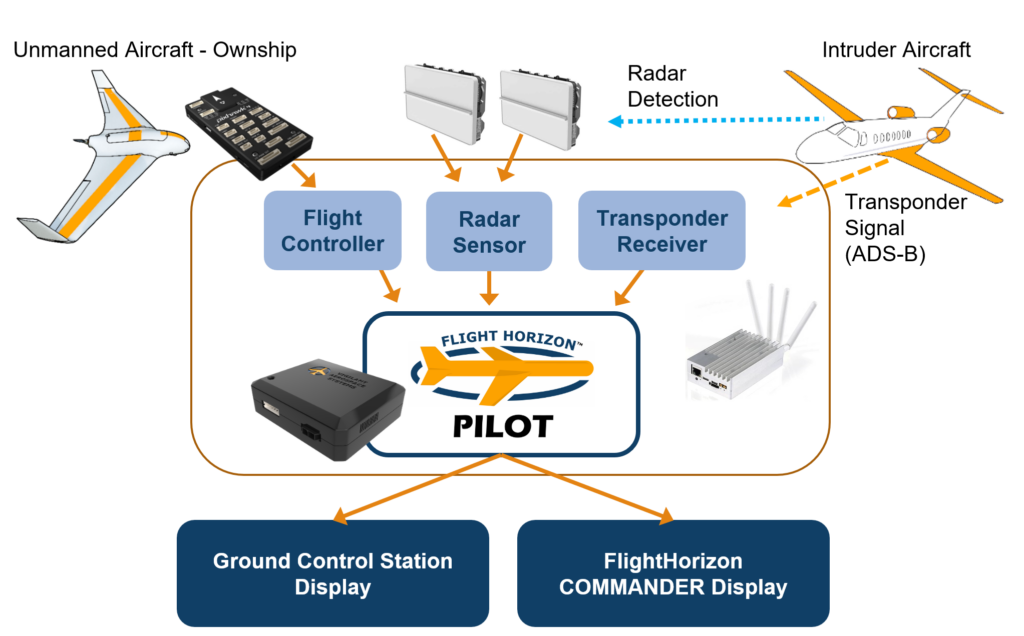FlightHorizon. Detect and avoid aircraft when flying beyond visual line-of-sight.
Do your commercial uncrewed aircraft operations require beyond visual line-of-sight flight, FAA Part 107.205 Line-of-Sight waiver, 333 Exemption Certificate of Authorization to fly beyond line-of-sight or other authorizations?
Do you need autonomous self-separation assurance?
Do you need to fly above 400’, fly near airports, at night or over water?
FlightHorizon, designed by NASA, provides a complete, standards-based autonomous collision avoidance solution for both piloted and fully autonomous unmanned aircraft to deliver situational awareness, self-separation commands, and collision avoidance for both piloted and autonomous unmanned aircraft.

PRODUCT BACKGROUND
Vigilant Aerospace Systems, Inc. provides the FlightHorizon family of products which use data from standard aviation transponders and radar to allow unmanned aircraft to autonomously self-separate from other aircraft and avoid mid-air collisions. This function is critical to allowing unmanned aircraft to fly beyond visual line-of-sight.
The system is based on an exclusively licensed NASA patent (#9,405,005) and prototype which has been extensively tested and which provides a unique autonomous “detect-and-avoid” function.
In addition, the software provides unmanned aircraft pilots with a 2D map-based view and 3D synthetic cockpit view of the airspace and full sensor fusion across aviation transponders, radars and online data feeds. The system is designed to help operators maintain flight safety, achieve beyond visual line-of-sight flight authorizations and comply with FAA Part 107.205 waiver requirements and upcoming RTCA SC-228 Phase II MOPS.
The company also provides integration and development consulting in addition to testing, training and compliance services for unmanned aircraft flight operation departments and fleet managers.
PRODUCTS
- FlightHorizon GCS™ – Uses an aviation transponder and, when available, ground-based radar attached to a laptop or workstation at the ground control station to provide collision avoidance commands and situational awareness to the ground-based unmanned aircraft pilot.
- FlightHorizon AIR™ – Uses onboard transponder data and, when available, radar data, delivered to the ground control station over a radio control channel to provide collision avoidance commands and situational awareness to the unmanned aircraft pilot.
- FlightHorizon PILOT™ – Uses onboard FlightHorizon computer, transponder data and, when available, radar data, to send self-separation commands directly to the onboard autopilot.
- FlightHorizon FLEET™ – Cloud-based online unmanned fleet management system that collects flight logs from multiple FlightHorizon installations to provide centralized reporting, license management and flight replays for fleets.
AWARDS AND AFFILIATIONS
- Winner of the FLC’s National Excellence in Technology Transfer Award 2017
- Winner of the FLC’s Far West Region Outstanding Commercialization Success Award 2016
- Member of the NASA Unmanned Traffic Management (UTM) Collaborative
- Invited Test Partner in the FAA’s ASSURE UAS Center of Excellence Research Program
ADDITIONAL TECHNICAL RESOURCES
- Product videos are available online at www.VigilantAerospace.com/video
In the News
Read more about Vigilant Aerospace Systems, Inc. and stay up-to-date with the latest company news by visiting our blog.
